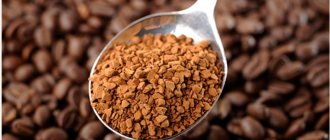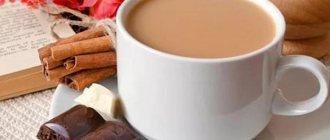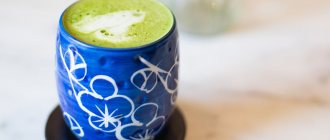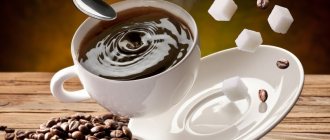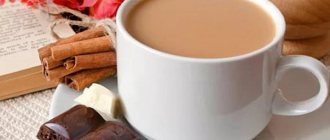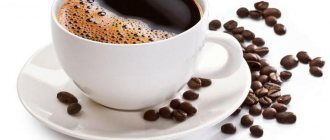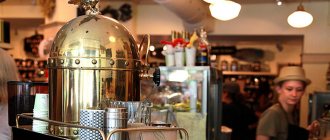Author: Yulia Sabinova. Updated 04/29/2017
When preparing many dishes, drinks and desserts, you may need to measure a certain amount of milk in grams or milliliters, so many may find it helpful to do this without a scale using a regular glass. Let's consider how much milk is contained in a faceted glass in grams and milliliters, as well as its calorie content in such a volume.
How to measure 100 grams of sugar without scales
The most common figure is exactly one tenth of a kilogram. This amount is added to baking dough, pancakes, and desserts. To measure it using the means at hand, look around the kitchen: which of the things listed in the table do you have?
| Capacity | Quantity, g |
| Jar, 1 l | 800 |
| Jar, 0.5 l | 400 |
| Thin glass glass | 210 |
| Faceted glass | 160/200 |
| Table spoon | 25 |
| dessert spoon | 10 |
| teaspoon | 5 |
The easiest way, of course, is to measure the required amount with a glass.
This will be either half or a little more, depending on the volume of the vessel itself. You should focus on the numbers written on the bottom. But there is no need to talk about accuracy in this case. So, if you need exceptionally correct grams, take a spoon. Similar mathematical precision is needed, for example, to prepare French macarons. Important!
If the volume of the glass is not indicated on the bottom, it can be measured using cutlery. Just keep track of how many table or dessert servings of sugar fit into it.
Glasses
If you find a cut Soviet classic in your home, you can breathe easy: you don’t have to worry about the accuracy of the measurements. If it is made according to all standards, then its volume is 250 milliliters, which is 200 grams of sugar. The edge is marked with a rim; if you add sand to this level, you will get exactly 160 grams.
With modern analogues it is more difficult: it all depends on the thickness of the glass, size, volume. Externally identical containers can hold different amounts of liquid. Usually the capacity is indicated on the bottom, and you should focus on it. A 150 ml glass will contain approximately 130 g of sugar, and a standard quarter-liter volume will contain all 200 g.
Important! If the volume is not indicated on your glass, you can look for it in the instructions or on the manufacturer’s website by selecting a similar product.
Spoons
The most accurate measuring device in your kitchen. To the question “100 grams of sugar is how many tablespoons?” You can answer exactly: four. The measurements become more accurate, but when it comes to large volumes this is not very convenient. There is a way out - find out how much can fit in any other container and use it as a control. There are several nuances with spoons:
- differences in parameters;
- amount of sand - with or without a slide;
- material thickness.
But due to the relatively small error, the error is reduced. To make measurements at home more accurate, pour sand into the spoon generously, but not heaping. The dining room will fit 25 grams, the dessert room, which is smaller - 10, and the tea room - 5. It is best to focus on standardized Soviet devices; the error will be minimal.
Budget Lenten chocolate pie devoured in one go
During Lent, I also want to treat myself to some delicious dessert. And lean chocolate is perfect for this...
Important! Sometimes you need to measure a non-standard amount of product - for example, 175 grams. To do this, you can measure two hundred in a glass, and then remove a tablespoon from the entire mass.
Unusual ways
If you don’t have any spoons or cans on hand, then try to find a container whose volume you know. This could be a yogurt box holding from 80 to 100 g, a bottle cap - 8 g, a jar of baby food, a ladle. If you have a liquid whose volume you know (for example, 200 ml of juice), pour it into any cup and measure the border. Then you can measure the amount of product poured up to a certain point. 100 milliliters usually contain 80-90 g of granulated sugar.
You can pour the required amount using measuring cups from a blender or multicooker. Measuring spoons and medicine bottles with a known volume can come to the rescue. In short, there are quite a few ways to calculate one hundred grams of sugar without scales.
Weight and volume in a faceted glass (ml, g)
How many ml in a glass? Volume of a faceted glass
– If you fill the glass to the rim , the volume of the product will be 200 ml .
– If you fill it to the top , the volume will be 250 ml .
How many grams are in a glass?
Different foods have different weights: water, flour, sugar, salt, etc. - You can measure the weight of these and other products using the table.
How many grams of water are in a glass?
If you pour it to the rim, you get 200 grams of water.
If you fill it to the top, there will be 250 g of water.
How much does an empty glass weigh?
An ordinary faceted glass (empty) weighs 220-230 g. The weight of other glasses can be from 170 to 250 grams.
Share on VKontakteFacebookOdnoklassniki
My world
After conducting a mini-research on custom glasses, we discovered two golden rules:
1. If the glass has a rim , then you need to fill it to the rim - then you get 200 ml
2. A glass without a rim - you need to fill it to the top - then you get 200 ml
But there can be exceptions to any rule, therefore, if in everyday life you use glasses other than standard faceted glasses, then we advise you to measure their volume once. This information will definitely come in handy when preparing dishes, even if you have scales at hand.
As practice shows, frequent work with scales quickly gets boring; moreover, in home recipes, products are often measured by volume rather than by weight - this makes scales useless in many cases.
Calorie content of sugar
It is very important to maintain accuracy, since sugar is a high-calorie product. There are 380 kilocalories in one hundred grams, that is, almost four in one gram. We often thoughtlessly add “a couple of spoons” to tea, not noticing that each of them contains from 16 to 20 calories, depending on whether the sweetener is heaped or not.
Lush curd balls in a frying pan without eggs
Curd balls are a very tasty and simple dessert that is usually enjoyed by both adults and children. Their s...
It’s easy to calculate that there are 95 kcal in a tablespoon. An average apple or several tangerines have the same energy capacity. And in a faceted glass there will be about 700 calories, depending on how you pour it. This is half the daily diet of an adult woman. So be careful when adding this sweetener to dough or desserts.
Measuring the right amount of product at home is easier than it seems at first glance. To do this, you only need dishes that are as close as possible to the standards. You can even get a special container: by measuring its volume once, you can always navigate in grams and measure out the amount of granulated sugar specified in the recipe without much difficulty.
Faceted glass with rim (200 ml) (glass No. 33, price 14 k)
An empty faceted glass weighs 220-230 grams.
If you pour water into such a glass exactly up to the rim , then its volume will be 200 ml and its weight will be 200 g (tested experimentally). If you fill it to the top, the volume will be 250 ml, and the weight of water will be 250 grams.
So, to correctly measure the volume of water, flour and other products and substances, a faceted glass should be filled exactly to the rim , or exactly to the top .
The measurement accuracy using such a glass can be quite high, for example, when checking the first time and without special preparation, 200.3 grams of water were poured into the glass.
A faceted glass should be filled exactly to the rim - this corresponds to a volume of 200 ml, or a water weight of 200 grams.
A faceted glass filled to the top holds 250 ml, which corresponds to the weight of water 250 g.
Antique glass with diamond-shaped edges
An empty glass weighs 173 grams.
This glass has no rim. If this glass to the top with water (until it starts to pour out), then the volume of the water contained will be equal to 200 ml, and its mass will be 200 g (tested experimentally).
This glass should be filled to the top - this corresponds to a volume of 200 ml, or a mass of water of 200 grams.
How many grams are in a plastic teaspoon?
In one teaspoon
always about 5
grams
of liquid.
Interesting materials:
How to invite people to a group on Facebook? How to invite strangers to a group in Odnoklassniki? How to invite more people to a Facebook group? How to invite someone to discord? How to invite someone to messenger? How to invite someone to Skype? How to invite people to a group on Facebook? How to invite another person to Skype? How does intuition manifest itself in a person? How to check where a person is registered?
Results
should be poured into a teaspoon or tablespoon possible , then its weight will correspond to the table (10 and 25 g). But our measurements showed that in reality, a teaspoon holds 1–2 grams less, and a tablespoon holds 2–3 g less. For most recipes, this difference is not important, but for a person it is only beneficial. Firstly, with numbers of 10 and 25 g it is much more convenient to count. Secondly, this way you will add and eat a little less sugar, and this will undoubtedly result in benefits for your health.
You need to pour sugar into a faceted glass without a top , level with the rim or edge of the glass.
Small glass with curly edges (glass No. 42)
An empty glass weighs 206 grams.
This glass does not have a rim. If this glass is filled to the top (until it starts to pour out), then the volume of the product will be 200 ml, and the mass of water will be 200 g.
So, to correctly measure the volume of water, flour and other products and substances, such a glass should be filled to the top.
This glass should be filled to the top - this corresponds to a volume of 200 ml, or a mass of water of 200 grams.
Table of weights and measures for milk
For quick orientation, you can use the table of weight ratios for cutlery of different capacities.
| Weight, g | Tbsp. | Ch.l. | Art. for 250 ml | Art. for 200 ml |
| 30 | 2.0 | 6 | 0.1 | 0.2 |
| 40 | 2.7 | 8 | 0.2 | 0.2 |
| 50 | 3.3 | 10 | 0.2 | 0.3 |
| 60 | 4.0 | 12 | 0.2 | 0.3 |
| 70 | 4.7 | 14 | 0.3 | 0.4 |
| 80 | 5.3 | 16 | 0.3 | 0.4 |
| 100 | 6.7 | 20 | 0.4 | 0.5 |
| 150 | 10 | 30 | 0.6 | 0.8 |
| 200 | 13.3 | 40 | 0.8 | 1 |
| 250 | 16.7 | 50 | 1 | 1.3 |
| 300 | 20 | 60 | 1.2 | 1.5 |
| 350 | 23.3 | 70 | 1.4 | 1.8 |
| 400 | 26.7 | 80 | 1.6 | 2 |
| 500 | 33.3 | 100 | 2 | 2.5 |
Pts on a measuring cup - what is it?
This type of abbreviation is usually seen on a blender cup. There are also words like cups and fl. oz. If everything is clear with the second and third, then the first is puzzling. Therefore, it will be news to many that the pts on the measuring cup is one pint. This unit of volume comes from the English system of measures. In Russia it is used quite rarely. It is mainly used in the UK, USA and Ireland. However, it is also interesting that the American and English pints have different sizes:
Finding out what these are - pts on a measuring cup, most likely, will only be necessary to satisfy your curiosity. Currently, this unit of volume is practically not used anymore. And it can also be seen less and less on modern measuring instruments.
How many glasses of sugar are in one kilogram?
To calculate how many glasses of sugar are in one kilogram, you need to again use simple mathematical calculations. It was stated above that in a large faceted glass with a rim, filled to the top, there are 200 grams of sugar. Accordingly, in 1 kilogram (1000 grams) there are 5 glasses of sugar: 1000 grams: 200 grams = 5 glasses.

